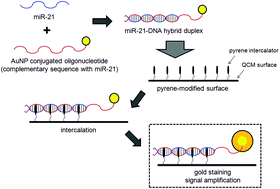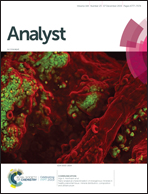QCM sensing of miR-21 by formation of microRNA–DNA hybrid duplexes and intercalation on surface-functionalized pyrene†
Abstract
MicroRNAs (miRNAs) are small non-coding RNA molecules that serve as important biomarkers for a variety of diseases such as cancer and vascular disease. However, sensitive and accurate detection of miR-21 is very challenging in that up-regulation of miR-21 is highly associated with several types of malignant tumors. Here, quartz crystal microbalance (QCM) biosensors were developed for sensitive and specific detection of miR-21 through formation of miR-21–DNA hybrid duplexes and non-specific intercalation of surface-modified pyrene molecules. High selectivity for miR-21 over other miRNAs came from the specific hybridization between miR-21 and gold nanoparticle (AuNP)-conjugated complementary oligonucleotides of miR-21. High sensitivity was obtained through formation of intercalated complexes on the surface with subsequent gold staining signal amplification. Under optimum condition using this strategic approach, our novel QCM biosensors could detect miR-21 concentration as low as 3.6 pM in the entire linear range from 2.5 pM to 2.5 μM with a correlation coefficient of 0.989. In addition, these sensors did not work at all for other miRNAs based on their high selectivity. miR-21 in human brain total RNA and total RNA extracted from A549 cell line could also be successfully detected. Therefore, miRNA detection technology using QCM biosensors and their detection mechanisms have potential as alternatives in biological studies and clinical diagnosis.



 Please wait while we load your content...
Please wait while we load your content...